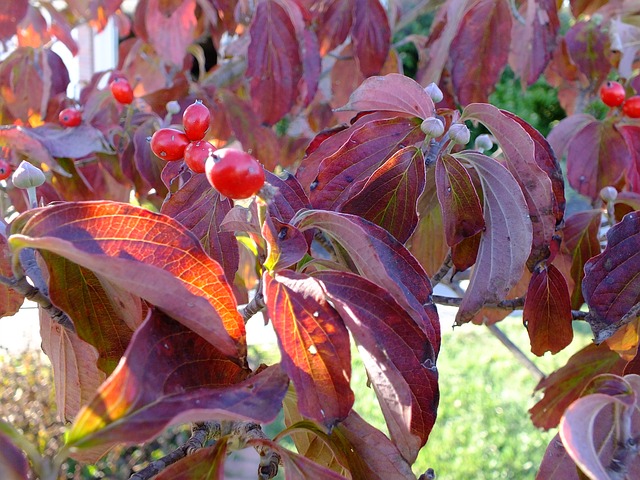This is the second half of a two part series on flowering dogwood cultivars.
Introduction
Flowering dogwood is one of the most frequently cultivated trees in the United States. More than one hundred cultivars are recognized by federal authorities, and several dozen are available for commercial use. The following examines some of the most notable varieties, and the traits that are characteristic of each, including ‘Hohman’s Gold’, ‘Kay’s Appalachian Mist’, ‘Pendula’, ‘Plena’, ‘Pluribracteata’, ‘Purple Glory’, ‘Rubra’, ‘Weaver’s White’, ‘Welch Bay Beauty’, and ‘Xanthocarpa’.
‘Hohman’s Gold’: ‘Hohman’s Gold’ is a variegated selection with a moderate growth habit, and an upright form. It is one of the smallest available cultivars, reaching 6 to 8 feet in height, with a 4 to 6 foot spread. Masses of cream colored flowers appear in early spring, surrounded by white bracts. In summer, elegantly rippled leaves become green and yellow, with tinges of pink. By fall, they turn a brilliant shade of red.
‘Kay’s Appalachian Mist’: ‘Kay’s Appalachian Mist’ is a small ornamental cultivar with a stunning horizontal branching habit. It is valued for its large white blooms, which are surrounded by white bracts in mid spring. Forest green foliage appears during flowering. Leaves turn a fiery red in fall. Red berries appear from early to late fall, providing contrast to the tree’s gray bark. ‘Kay’s Appalachian Mist’ exhibits strong resistance to powdery mildew, and other diseases that affect the parent species.
‘Pendula’: ‘Pendula’ is one of the most popular cultivars of flowering dogwood. It reaches 15 to 20 feet in height and width, and establishes a horizontal to upright branching pattern. While ‘Pendula’ is celebrated for its attractive pink to white flowers, which are surrounded by white bracts, it is perhaps most notable for its distinct weeping habit that differentiates it from other selections. It also features distinct green leaves that are oval shaped, and vertically curved. In fall, leaves deepen in color, turning red to purple. By winter, ‘Pendula’ sheds its leaves, and produces small red berries, which grow in masses along the bare branches.
‘Plena’: ‘Plena’ is a small ornamental cultivar with a compact form. It grows at a slow rate, reaching a height and spread of 8 to 12 feet. In spring, white flowers appear, enveloped by 17 to 24 large white bracts. Foliage is bright green, before turning shades of red and purple in fall.
‘Pluribracteata’: ‘Pluribracteata’ is a rare variety of flowering dogwood that is most common across the eastern United States. Depending on the growing conditions, this cultivar may be considered a medium sized shrub, or small ornamental tree. In forested settings, it often grows between 15 and 20 feet in height and width. Garden-cultivated plants are smaller, reaching 6 to 10 feet in height and width. Clusters of white flowers emerge in spring, surrounded by large white bracts blushed with light green. In autumn, flowers are displaced by bright red, glossy berries that persist throughout winter. During flowering, broadly ovate green leaves appear. Leaves turn variations of red in fall, presenting a striking display.
‘Purple Glory’: ‘Purple Glory’ is a small cultivar that grows 15 to 20 feet in height and width. Flowers with showy maroon-red bracts bloom in spring. During flowering, light purple leaves emerge, deepening to dark purple as they mature. In fall, leaves darken further, turning shades of black and purple. Leaves retain their color for an extended period, fading in late fall or early winter.
‘Rubra’: ‘Rubra’ is a small ornamental tree that reaches 15 to 30 feet in height, with a 20 to 25 foot spread. It produces pink to red-pink flowers, surrounded by similarly colored bracts that open flat, creating the appearance of a single, large flower. Ovate green leaves appear in spring, turning red in fall.
‘Weaver’s White’: ‘Weaver White’ is a variety of flowering dogwood that grows 20 to 30 feet tall, and 25 to 30 feet wide. It has a wide spreading form, with a candelabra shape, and a horizontal branching habit. This cultivar is valued for its large white blooms that are held atop the branches in mid spring. Flowers are white with creamy white overtones, and white bracts. Forest green foliage emerges in spring, turning an outstanding brick red or maroon in fall. Glossy, red berries appear from early to late fall, contrasting well with the tree’s gray bark.
‘Welch Bay Beauty’: ‘Welch Bay Beauty’ is a small cultivar with a horizontal to upright branching habit. It grows 15 to 20 feet in height and width. This cultivar features white to pink spring flowers with white bracts, and ovate, vertically curved green leaves that turn vibrant shades of red and purple in fall. ‘Welch Bay Beauty’ retains its leaves until late in the season, whereupon masses of red winter berries appear.
‘Xanthocarpa’: ‘Xanthocarpa’ is a small cultivar with a rounded to flat-topped growth habit. It reaches 15 to 20 feet in height and width. This cultivar produces pink to white flowers, with white bracts in spring. New foliage is tinged yellow-green, turning red or burgundy in fall. Leaves retain their color until late fall or early winter. ‘Xanthocarpa’ is most notable for its bright yellow fruit, which differentiates it from other cultivars.


